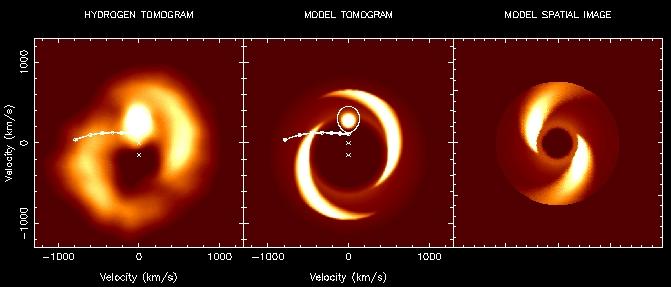IP Pegasi

IP Pegasi. The accretion disk surrounding the white dwarf has been shown to have a spiral pattern. The disk itself is smaller than the Sun's diameter, so the spiral pattern can't be imaged directly by telescopes. Instead, the spiraling disk of gas is mapped over a series of observations using a spectroscopic technique known as Doppler tomography. The left panel shows a tomogram, the directly measured gas velocity map for the system. The relative brightness corresponds to the intensity of light emitted by hydrogen gas moving at the indicated velocity. The position at the centre of this panel represents the velocity of the binary system's center of mass. In the middle panel, a simple model velocity field consistent with the measurements is shown. At the right, the calculated position map of the IP Pegasi accretion disk reveals a two-armed trailing spiral pattern. Credit: D. Steeghs, E. Harlaftis, K. Horne, Astronomy Group, Univ. St. Andrews.
IP Pegasi is a U Geminorum star (dwarf nova) that is also an eclipsing binary with an orbital period of 3.80 hours. It contains a 1.02 solar mass white dwarf and a 0.5 solar mass red dwarf companion, which feeds the white dwarf's accretion disk. IP Pegasi undergoes disk instabilities causing dwarf nova disk outbursts approximately every 3 months. It is one of the few eclipsing U Gem systems for which the inclination of the orbital plane is large enough for the companion star to eclipse the white dwarf primary, the accretion disk, and the hot spot (the place where the gas stream hits the outer of edge of the accretion disk). The study of its deep eclipses has provided valuable information on the evolution of accretion disks and the mechanism of outbursts in cataclysmic variables.


